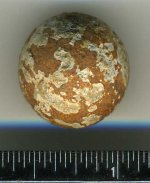Erik in NJ
Silver Member
- Oct 4, 2010
- 4,037
- 3,043
- 🥇 Banner finds
- 1
- Detector(s) used
- Minelab Explorer SE Pro & CTX-3030
- Primary Interest:
- Metal Detecting
This lead ball was found on the former British Isle not far from where I found the beautiful 1600's Openwork Bridal Boss. It is round and measures approx 5/8" in diameter. It was found in a somewhat wet area. Thanks fo any help!



 But he clearly states that it was found on a former British Isle. So why is military (REV.WAR-Civil War) involved
But he clearly states that it was found on a former British Isle. So why is military (REV.WAR-Civil War) involved

 I've got no problem with the whole deal as long as the poster of the thread don't go away thinking that all small size musket balls have to be after the Rev. War.(not true) I've provided plenty of proof otherwise for that statement.
I've got no problem with the whole deal as long as the poster of the thread don't go away thinking that all small size musket balls have to be after the Rev. War.(not true) I've provided plenty of proof otherwise for that statement. 





